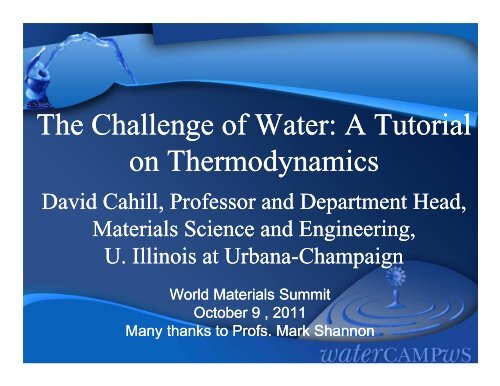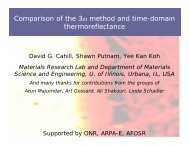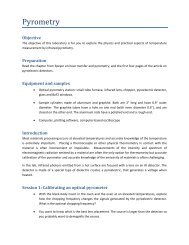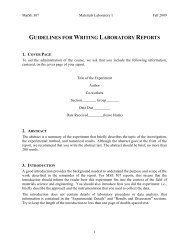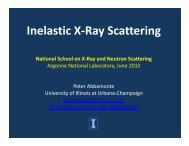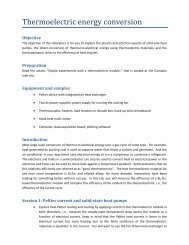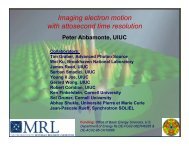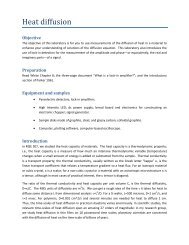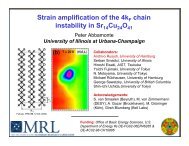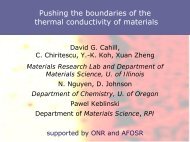A Tutorial on Thermodynamics - University of Illinois at Urbana ...
A Tutorial on Thermodynamics - University of Illinois at Urbana ...
A Tutorial on Thermodynamics - University of Illinois at Urbana ...
- No tags were found...
Create successful ePaper yourself
Turn your PDF publications into a flip-book with our unique Google optimized e-Paper software.
Sec<strong>on</strong>d Law <strong>of</strong> <strong>Thermodynamics</strong>SourceT hSinkT cHe<strong>at</strong> QEntropy Q/T hQW WT Tc hElectrical energy WHe<strong>at</strong>engineQ-WEntropy (Q-W)/T cMark A. Shann<strong>on</strong> http://w<strong>at</strong>ercampws.uiuc.edu3
Sec<strong>on</strong>d Law <strong>of</strong> <strong>Thermodynamics</strong>QW Q Tc W 1TcTh ThQ In typical steam cycles (coal, nuclear) he<strong>at</strong>flow into cold he<strong>at</strong> sink is approxim<strong>at</strong>ely thesame as electrical power (Q-W) ≈ W (andcomparable to he<strong>at</strong> lost to exhaust) Need to dissip<strong>at</strong>e W <strong>of</strong> he<strong>at</strong> <strong>at</strong> as low <strong>of</strong> <strong>at</strong>emper<strong>at</strong>ure as possible.Mark A. Shann<strong>on</strong> http://w<strong>at</strong>ercampws.uiuc.edu4
Cooling requirements inpower gener<strong>at</strong>i<strong>on</strong> Most effective way to do this iswith w<strong>at</strong>er, either by a he<strong>at</strong>inga large volume by a smallamount and then discharge toenvir<strong>on</strong>ment, or byevapor<strong>at</strong>i<strong>on</strong>. Discharge is warm andincreases evapor<strong>at</strong>i<strong>on</strong> sooverall c<strong>on</strong>sumpti<strong>on</strong> <strong>of</strong> w<strong>at</strong>er issimilar in both cases.Mark A. Shann<strong>on</strong> http://w<strong>at</strong>ercampws.uiuc.edu5
Cooling requirements in powergener<strong>at</strong>i<strong>on</strong> He<strong>at</strong> <strong>of</strong> vaporiz<strong>at</strong>i<strong>on</strong> <strong>of</strong> w<strong>at</strong>er is 2 J/mm 3 or 2GJ/m 3 In other words, need to evapor<strong>at</strong>e 0.5 m 3 <strong>of</strong>w<strong>at</strong>er per sec<strong>on</strong>d for a 1 GW nuclear powerplant. Order <strong>of</strong> magnitude the same as thehousehold w<strong>at</strong>er use (in the US) <strong>of</strong> a smallcity <strong>of</strong> 100,000 (e.g., Champaign-<strong>Urbana</strong>,IL)Mark A. Shann<strong>on</strong> http://w<strong>at</strong>ercampws.uiuc.edu6
Why not use more air cooling? Volume <strong>of</strong> air involved is huge. He<strong>at</strong> capacity per molecule is (7/2)k B He<strong>at</strong> capacity per unit volume is(7/2)(P/T)≈1kJ/m 3 -K <strong>at</strong> ambient c<strong>on</strong>diti<strong>on</strong>s With ∆T=10 K, requires nearly 10 5 morevolume <strong>of</strong> air than evapor<strong>at</strong>ing w<strong>at</strong>er. Enormous he<strong>at</strong> exchangers, fans, high capitalcosts.Mark A. Shann<strong>on</strong> http://w<strong>at</strong>ercampws.uiuc.edu7
Why not use more air cooling? Efficiency suffers: 0.1% per degree C. Air temper<strong>at</strong>ure is not always as cold asavailable w<strong>at</strong>er. Worse in hot/clim<strong>at</strong>es wheremore air-c<strong>on</strong>diti<strong>on</strong>ing is needed. Additi<strong>on</strong>al thermal resistance because he<strong>at</strong>transfer is not as effective: basic property <strong>of</strong>effusivity (square root <strong>of</strong> the product <strong>of</strong>thermal c<strong>on</strong>ductivity and he<strong>at</strong> capacity perunit volume) is smaller by a factor <strong>of</strong> 100. Trade-<strong>of</strong>f: do you want to reduce use <strong>of</strong>H 2 O or CO 2 emissi<strong>on</strong>?Mark A. Shann<strong>on</strong> http://w<strong>at</strong>ercampws.uiuc.edu8
Why not use more air cooling? Combined cycle (n<strong>at</strong>ural gas powered)saves w<strong>at</strong>er and reduces CO 2 rel<strong>at</strong>ive tocoal.cogenerti<strong>on</strong>.netMark A. Shann<strong>on</strong> http://w<strong>at</strong>ercampws.uiuc.edu9
<strong>Thermodynamics</strong> <strong>of</strong> w<strong>at</strong>er purific<strong>at</strong>i<strong>on</strong>PureW<strong>at</strong>erBest we can do isW=∆μNPumpElectrical energy WSaltW<strong>at</strong>erChemical work = ∆μN,∆μ = change in chemical potentialN = number <strong>of</strong> w<strong>at</strong>er molecules10Mark A. Shann<strong>on</strong> http://w<strong>at</strong>ercampws.uiuc.edu
<strong>Thermodynamics</strong> <strong>of</strong> w<strong>at</strong>er purific<strong>at</strong>i<strong>on</strong> Lowest possible energy is for a reversibleprocess.Semi-permeable membranePurew<strong>at</strong>erSaltw<strong>at</strong>erPist<strong>on</strong> applies pressure = osmotic pressure11Mark A. Shann<strong>on</strong> http://w<strong>at</strong>ercampws.uiuc.edu
<strong>Thermodynamics</strong> <strong>of</strong> w<strong>at</strong>er purific<strong>at</strong>i<strong>on</strong> For ideal soluti<strong>on</strong> <strong>of</strong> n i<strong>on</strong>s per unit volume nk TB Differential work d<strong>on</strong>e in moving volumedVdW ( dV ) Integr<strong>at</strong>e from initial to final osmotic pressure(assume 50% recovery)(1/2) V0VW k T n0dVB VV012Mark A. Shann<strong>on</strong> http://w<strong>at</strong>ercampws.uiuc.edu
<strong>Thermodynamics</strong> <strong>of</strong> w<strong>at</strong>er purific<strong>at</strong>i<strong>on</strong> For 50% recovery, ideal soluti<strong>on</strong>, 3.5% bymass NaCl (V 0 = 2 m 3 to recover 1 m 3 purew<strong>at</strong>er)WWnV k T ln(2)0 B3.8 MJ 1 kWh No process can do better than this <strong>at</strong> 50%recovery. (For 0% recovery, no ln(2) term.) St<strong>at</strong>e-<strong>of</strong>-the-art RO is <strong>on</strong>ly a factor <strong>of</strong> 2 higherthan this limit.13Mark A. Shann<strong>on</strong> http://w<strong>at</strong>ercampws.uiuc.edu
Is 1 kWh = 3.6 MJ a lot <strong>of</strong> energy? Electrical power cost is about $0.10 He<strong>at</strong> 10 L <strong>of</strong> w<strong>at</strong>er to boiling point Light a CF light bulb for a few days Run a refriger<strong>at</strong>or for ½ day Do 3600 google searches One google search c<strong>on</strong>sumes as muchenergy as st<strong>at</strong>e-<strong>of</strong>-the-art RO uses to purify asmall cup <strong>of</strong> w<strong>at</strong>er.14Mark A. Shann<strong>on</strong> http://w<strong>at</strong>ercampws.uiuc.edu
Thermodynamic limits for a distill<strong>at</strong>i<strong>on</strong>process are the same For a reversible process, we have to makethe vapor pressures equal (almost) but th<strong>at</strong>means the temper<strong>at</strong>ure <strong>of</strong> the salt w<strong>at</strong>er ishigherSaltW<strong>at</strong>erPureW<strong>at</strong>erT h T c TcApproxim<strong>at</strong>e he<strong>at</strong> input: 1∆H=enthalpy <strong>of</strong> vaporiz<strong>at</strong>i<strong>on</strong>per unit volumedQ H dV Th15Mark A. Shann<strong>on</strong> http://w<strong>at</strong>ercampws.uiuc.edu
Thermodynamic limits for distill<strong>at</strong>i<strong>on</strong> Real-world distill<strong>at</strong>i<strong>on</strong> processes (multi-stage)work far from the thermodynamic limit. T cdW H 1dV Th Even for ∆T=10 K, this is 15 times worse thanthe thermodynamic limit.16Mark A. Shann<strong>on</strong> http://w<strong>at</strong>ercampws.uiuc.edu
But maybe sometimes he<strong>at</strong> is free, i.e.,“waste he<strong>at</strong>”? Low-grade (low temper<strong>at</strong>ure) he<strong>at</strong> sourceth<strong>at</strong> is not feasible to use in electrical powergener<strong>at</strong>i<strong>on</strong> might be used to purify w<strong>at</strong>er. But keep in mind th<strong>at</strong> high efficiency powergener<strong>at</strong>i<strong>on</strong> uses low temper<strong>at</strong>ure he<strong>at</strong> sinks.Not much <strong>of</strong> the he<strong>at</strong> is “wasted”17Mark A. Shann<strong>on</strong> http://w<strong>at</strong>ercampws.uiuc.edu


